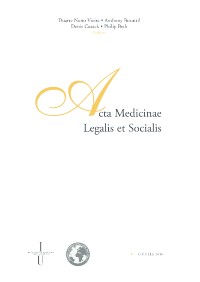Please use this identifier to cite or link to this item:
https://hdl.handle.net/10316.2/31709| DC Field | Value | Language |
|---|---|---|
| dc.contributor.author | Fuzinato, D. V. | |
| dc.contributor.author | Silva, S. F. S. M. | |
| dc.contributor.author | Fontes, L. R. | |
| dc.contributor.author | Vieira, D. N. | |
| dc.contributor.author | Mendonça, M. C. N. | |
| dc.contributor.author | Morais, J. L. | |
| dc.contributor.author | Marino, M. | |
| dc.date.accessioned | 2014-06-25T14:33:59Z | |
| dc.date.accessioned | 2020-09-20T21:07:29Z | - |
| dc.date.available | 2014-06-25T14:33:59Z | |
| dc.date.available | 2020-09-20T21:07:29Z | - |
| dc.date.issued | 2010 | - |
| dc.identifier.isbn | 978-989-26-0173-1 (PDF) | |
| dc.identifier.uri | https://hdl.handle.net/10316.2/31709 | - |
| dc.description.abstract | This paper presents the preliminary results of the Archaeographic Plan of Action of the graves of religious in the Mosteiro da Luz, founded in 1774 and now in the central area of São Paulo, the largest and most urbanized city in Brazil. In the old cemetery inside a small chapel, 6 wall graves were found, and 1 soil grave with a funerary headstone. The procedures for preliminary archaeography were satisfactory to assist in mapping the spatial distribution of the human remains: use of burial terminology, subsuperficial scanning, photogrammetry, drawing and digital photography. Through the methods and techniques of forensic archaeology, there were identified, documented and preserved in situ 3 mummies and 6 skeletons. A major risk, that determined an emergencial intervention for the site preservation, was the building infestation by the exotic subterranean termite, Coptotermes gestroi, that imposed severe bioturbation to most corpses. Termite bioturbation can now be assigned as a major risk for the archaeological and anthropological patrimony in urban areas in Brazil | eng |
| dc.language.iso | eng | - |
| dc.publisher | Imprensa da Universidade de Coimbra | por |
| dc.publisher | International Academy of Legal Medicine | por |
| dc.relation.ispartof | http://hdl.handle.net/10316.2/2632 | por |
| dc.rights | open access | - |
| dc.title | Archaeology of death and forensic sciences in Mosteiro da Luz, São Paulo, Brazil: the excavation can make a difference inforensic anthropological study of mummies and skeletons | por |
| dc.type | bookPart | por |
| uc.publication.firstPage | 23 | - |
| uc.publication.lastPage | 28 | - |
| uc.publication.location | Coimbra | por |
| dc.identifier.doi | 10.14195/978-989-26-0173-1_3 | - |
| uc.publication.digCollection | PB | por |
| uc.publication.orderno | 3 | - |
| uc.publication.area | Ciências da Saúde | por |
| uc.publication.bookTitle | Acta medicinae legalis et socialis | - |
| uc.publication.manifest | https://dl.uc.pt/json/iiif/10316.2/31709/225827/manifest?manifest=/json/iiif/10316.2/31709/225827/manifest | - |
| uc.publication.thumbnail | https://dl.uc.pt/retrieve/11402287 | - |
| uc.publication.parentItemId | 52204 | - |
| uc.itemId | 73302 | - |
| item.grantfulltext | open | - |
| item.fulltext | With Fulltext | - |
| Appears in Collections: | Acta medicinae legalis et socialis | |
Files in This Item:
| File | Description | Size | Format | |
|---|---|---|---|---|
| 1_2.1_-_acta_medicinae_legalis.pdf | 2.32 MB | Adobe PDF |  |
Items in DSpace are protected by copyright, with all rights reserved, unless otherwise indicated.
